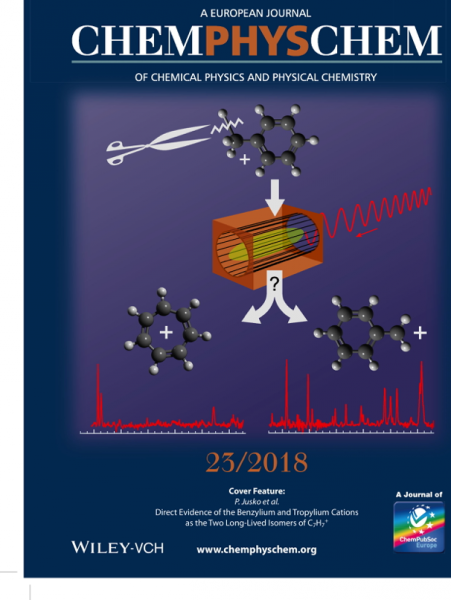Benzylium and tropylium cations identified as the two stable isomers of C7H7+
Experiments conducted by an international team involving the Institut de recherche en astrophysique et planétologie (IRAP, University of Toulouse/CNRS) and the Laboratoire de chimie et physique quantiques (LCPQ, University of Toulouse/CNRS), have identified the two stable isomers of the C7H7+ ion.

The C7H7+ ion is a species well known in mass spectrometry that is formed by ionization of hydrocarbons such as toluene. The two most stable structures proposed for this ion are the benzylium and the tropylium ions. The first one (a benzene with a methylene group) could be identified by its chemical reactivity but this is not the case of the second one whose structure composed of an aromatic 7-carbon ring is predicted by quantum chemistry calculations.
The study benefited from the installation of the FELion line on the FELIX free electron laser in the Netherlands. FELion includes a cryogenic ion trap that allows to attach a rare gas atom to the ions studied. This technique, known as tagging, makes it possible to implement an action spectroscopy by dissociation of the ion/rare gas atom complex with a single infrared photon, unlike the technique of multiple absorption of photons generally used to reach the dissociation threshold of the ion. This technique has the advantage of probing the ions without heating them and therefore without disturbing their structure through isomerization processes.
Two structures could be identified for C7H7+ and the vibration spectra obtained are in agreement with those of the benzylium and the tropylium ions calculated with the theory of the functional density. In addition, depletion measurements showed that no other isomers were present for different precursors used for the production of C7H7+.
This work to identify the isomers of C7H7+ opens up perspectives for the study of hydrocarbon ion growth paths in complex medium both on Earth (flame and plasma chemistry) and in space (interstellar chemistry and planetary atmospheres such as that of Titan).
This interdisciplinary work (INSU/INP/INC) was initiated as part of the ERC Synergy NANOCOSMOS project in collaboration with the CSIC (Madrid) and involves collaboration between the Universities of Toulouse and Cologne as part of the EUROPAH European Training Network (ETN).
Further Resources
- Publication : P. Jusko, A. Simon, S. Banhatti, S. Brünken, C. Joblin (2018) Direct Evidence of the Benzylium and Tropylium Cations as the two long-lived Isomers of C7H7+, ChemPhysChem, doi: 10.1002/cphc.201800744 – Archives ouvertes: hal-01880438, arXiv:1809.09375
IRAP Contact
- Christine Joblin, christine.joblin@irap.omp.eu, 05 61 55 86 01






